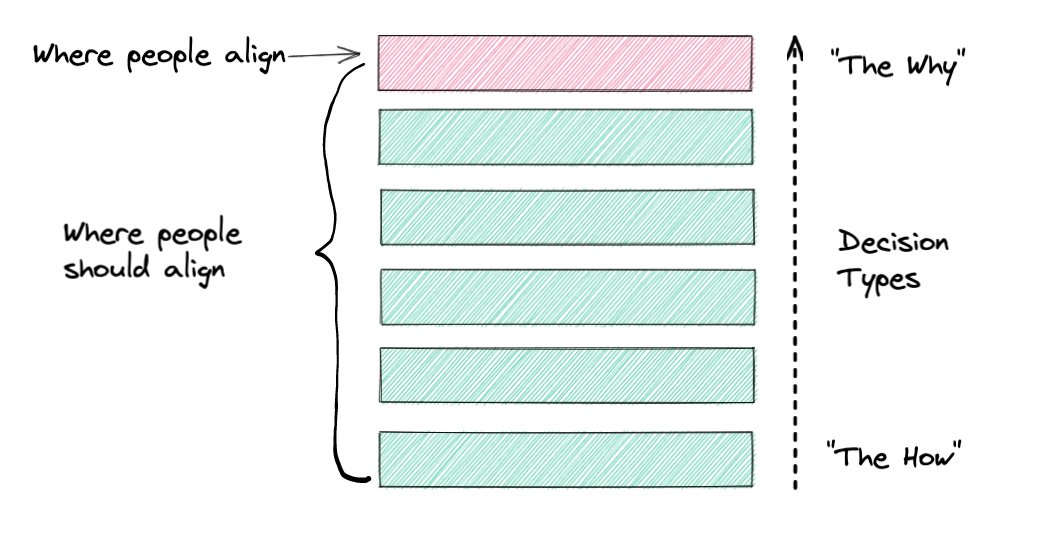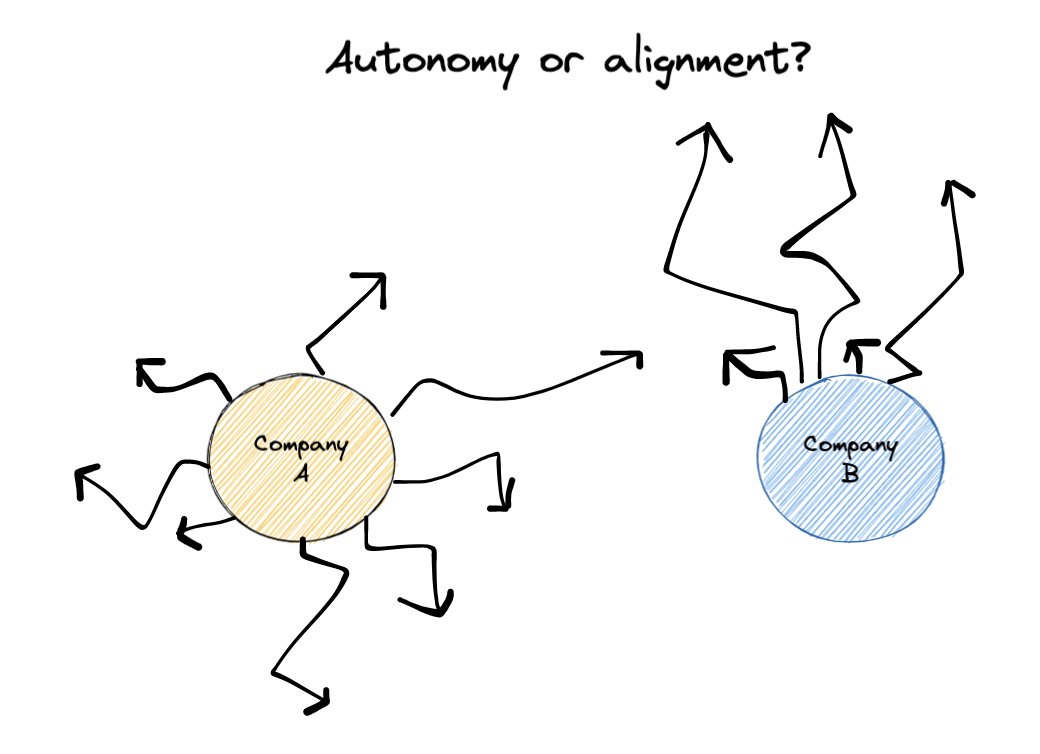Alignment > Autonomy
It's easier to measure and feel high autonomy than it is to measure high alignment. But without alignment, autonomy is squandered.
I’m often asked about the worst leadership advice I’ve ever been given. By far the worst is “hire great people and get out of their way”.
This one will take some explaining… so let’s start at the start.
After a year leading engineering at Atlassian my boss told me in my perf review that I was doing ok but wondered why I didn’t talk and involve him more regularly. My answer was “I thought that was my job — to take away all this crap from you and let you do your CEO thing. I thought you wanted me to be autonomous. I need autonomy.”
He said sure, but you should cheat “and use my brain to help you”

At that point I changed some habits, involved him more in different ways, got over the autonomy complex, and we got a lot more done together. I learned a lot and we made better decisions.
Since then I’ve hired many leaders and had to repeat the same conversation that my boss had with me over and over and over. It turns out that everyone defaults to expect the wrong version of autonomy.
These experiences sent me down a multi-year reflection. Why did I feel like success was maximizing autonomy and showing that I could take care of things without bugging my boss? I prioritized autonomy over alignment. It’s a million times easier to measure and feel high autonomy than it is to measure high alignment.
What I’ve learned since, way too slowly, is that companies are performing a monumental balancing act trying to decide what 98% of their problem space to focus, what to ignore, and how to ship. That’s your strategy. And it’s complex, ambiguous, and changing.
The hardest part of building a company is alignment on strategy and clearly communicating it. Think about it this way, a 1 degree deviation in course of a rocket heading to the sun means it will miss the sun by 1.2 million miles. A lack of alignment compounds quickly.
Every leader in the company is trying to keep on course using the strategy as a compass… and readjusting as new information comes in. You’re never confronted with problems that are independent of each other. Your problems are part of a complex systems & interact with each other.
Situational messes.
Much of the alignment process is understanding the mess with others. And then simplifying it and focusing. Alignment is the difference between progress and stagnation. You need a good level of alignment on everything, from culture and architecture to which customers to build for which to not build for.

And here’s the hard part…the second you leave an alignment meeting, you’re mis-aligned again. That’s fine, it’s normal.
Alignment decays incredibly quickly.
There’s also mass confusion on what to align on? Most people just want to know the very high level goals. And this causes most companies that I work with to align superficially. Their strategy is a superficial incomplete map, they don’t remove scope, communicate clearly, etc… Here’s an example. If you want to sail a boat across the Atlantic, what is your strategy?
Strategy 1: Leave from Portugal and head towards St Lucie and not die. And have fun!
But that’s not a strategy…
Strategy 2: when do we leave and why? What kind of boat and why? What systems do you have & backups, how many crew, sail selection, route planning options?
Strategy is multi-faceted and evolving. You can discuss this strategy in depth, but not do the trip together.
The biggest alignment problem is the gap between how much people think they have to align versus what they should align on. There are many strategic decisions in the “how”. eg, what technologies to use, new system vs integration, build in core or in an app.

Alignment forces you to talk with your boss and peers to:
- define a strategy, narrow focus
- communicate it clearly together
- and ensure you’ve hired enough people who appreciate the value and difficulty of alignment and can fill in the implementation details with their teams
So…when you hire someone or you have a new leader, your number one job is alignment. And you do this continuously. It’s definitely never going to be “hire them and get out of their way”.
There is so much research on pair programming, yet we don’t have the same cultural acceptance of pairing in leadership. But paired leadership is mandatory.
If you read the case for pair programming you’ll notice that every single advantage of pair programming applies to paired leadership.
But why are we in this predicament of worshipping autonomy more than alignment? I know what you’re thinking. Isn’t this micro-managing?
It isn’t.
Scott and Tobi let me run the team and implement our strategy fully.
But together we frequently dug into the “how” to understand and navigate the nuances of our strategy together and often. Tech companies worship autonomy to distance themselves from any inkling of command-and-control. If you get labelled as micro-managing you’re burnt at the stake. But the nuances or organizational problem solving has been lost.
Without alignment, autonomy is squandered.
Even after all this, I messed up again in 2015 when starting at Shopify. Tobi gave me the same feedback again… I’m a slow learner.
At that point I told myself… You HAVE to take responsibility for alignment. It’s YOUR job, as much as your bosses. I’ve became very upfront about alignment with new hires. Gist of our first conversation is:
“We’re going to spend more time pairing and going deep on strategy and decisions than you’re used to… we have a lot to learn from each other…but you’ll own the implementation.” …and then I’ll share these 3 alignment tips with them that we can use together.
First tip, be clear and open about the types of conversations you need with your direct reports:
- 25% of my time your boss,
- 50% your peer,
- 25% I work for you
This encourages collaboration and sets the tone of alignment and a strong habit of working together.

Second tip is from Susan Scott, author of “Fierce Conversations,” offers a wonderful alignment model: the Decision Tree.

The decision tree is great as it’s a reminder that you don’t have to align on everything. Decisions have different costs to unwind. Spend time alignment based on the impact of the decisions.
Third tip: take FULL responsibility for alignment with your boss and peers. Send your boss at minimum 2 async notes a week. Decisions, wins, lessons, how you’re doing. Schedule it in your calendar. Seek feedback, but share decision logic not just outcomes. Feel responsible, take ownership of alignment. Don’t blame the process. It takes active work to build and maintain. You’ll make better decisions.
Netflix’s slogan of “highly aligned, loosely coupled” was spot on. But it’s a lot harder to implement than you think. Without alignment, autonomy is squandered.
So hire great people, and expect highly coupled frequent alignment with loosely coupled implementation.